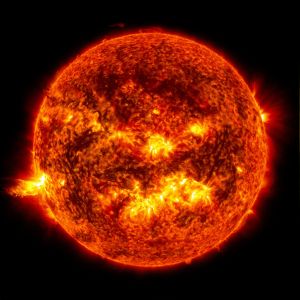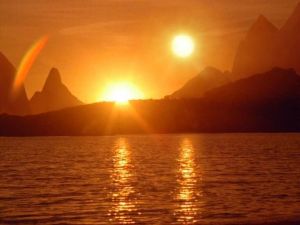Difference between revisions of "Star"
m |
m |
||
| Line 4: | Line 4: | ||
: '''''Sun''' redirects here. For information on [[Earth]]'s sun, see [[Sol]].'' | : '''''Sun''' redirects here. For information on [[Earth]]'s sun, see [[Sol]].'' | ||
| − | A '''star''' (or "'''sun'''") is a massive [[energy]]-producing sphere of [[plasma]] and [[gas]] located in [[space]]. The region around a star that is held by its [[gravity]], including any [[planet]]s, [[moon]]s, | + | A '''star''' (or "'''sun'''") is a massive [[energy]]-producing sphere of [[plasma]] and [[gas]] located in [[space]]. The region around a star that is held by its [[gravity]], including any [[planet]]s, [[moon]]s, comets, and [[asteroid]]s, is called a [[star system]]. |
==Stellar life cycle== | ==Stellar life cycle== | ||
| Line 14: | Line 14: | ||
Stars can be made up of various different elements depending on their age. | Stars can be made up of various different elements depending on their age. | ||
| − | Young stars mainly consist of | + | Young stars mainly consist of hydrogen, which is fused to helium thereby increasing the star's helium ratio over time and producing large quantities of energy. This energy, in turn, creates extreme pressure, preventing the star from collapsing under its own gravity. |
*Dr. [[Tolian Soran]] used a [[Trilithium]] weapon in [[2371]] to stop all fusion reactions inside the [[Amargosa]] sun, thereby collapsing the star and altering the gravitational conditions in the system. | *Dr. [[Tolian Soran]] used a [[Trilithium]] weapon in [[2371]] to stop all fusion reactions inside the [[Amargosa]] sun, thereby collapsing the star and altering the gravitational conditions in the system. | ||
| Line 34: | Line 34: | ||
*In [[2269]], the star [[Beta Niobe]] turned to a supernova, when crewmembers of the [[Federation]] [[starship]] {{USS|Enterprise|NCC-1701}} were almost trapped on its planet [[Sarpeidon]]. | *In [[2269]], the star [[Beta Niobe]] turned to a supernova, when crewmembers of the [[Federation]] [[starship]] {{USS|Enterprise|NCC-1701}} were almost trapped on its planet [[Sarpeidon]]. | ||
| − | *The resulting electromagnetic pulse from the supernova of [[Beta Magellan]] in [[2364]] was so feared by the computer-dependent [[Bynar]] in the nearby [[Beta Magellan system]] that they commandeered the {{USS|Enterprise|NCC-1701-D|-D}} as a temporary dump for their planetary | + | *The resulting electromagnetic pulse from the supernova of [[Beta Magellan]] in [[2364]] was so feared by the computer-dependent [[Bynar]] in the nearby [[Beta Magellan system]] that they commandeered the {{USS|Enterprise|NCC-1701-D|-D}} as a temporary dump for their planetary computer. |
*In [[2373]], a series of supernovae witnessed by the {{USS|Voyager}} in the [[Delta Quadrant]] turned out to be the real-time result of "battles" during a civil war in the [[Q Continuum]]. They were actually created by spatial disruptions in the Continuum, which created a negative-density false vacuum that sucked nearby matter into the Continuum. | *In [[2373]], a series of supernovae witnessed by the {{USS|Voyager}} in the [[Delta Quadrant]] turned out to be the real-time result of "battles" during a civil war in the [[Q Continuum]]. They were actually created by spatial disruptions in the Continuum, which created a negative-density false vacuum that sucked nearby matter into the Continuum. | ||
Revision as of 14:42, 22 June 2021
This article or section requires an update. |
A star (or "sun") is a massive energy-producing sphere of plasma and gas located in space. The region around a star that is held by its gravity, including any planets, moons, comets, and asteroids, is called a star system.
Contents
Stellar life cycle
Formation
Stars are born out of huge gaseous nebulae. Inside these nebulae, centers of higher density form, slowly accumulating more mass as the center's gravity increases, to form a protostar. Pressure in the interior of the protostar rises, in turn increasing the density and temperature until the gas turns to plasma, where the atomic nuclei and the electrons are dissociated from each other. At a sufficient temperature and pressure, nuclear fusion is initiated at the core, producing light: the star is born.
Star evolution
Stars can be made up of various different elements depending on their age.
Young stars mainly consist of hydrogen, which is fused to helium thereby increasing the star's helium ratio over time and producing large quantities of energy. This energy, in turn, creates extreme pressure, preventing the star from collapsing under its own gravity.
- Dr. Tolian Soran used a Trilithium weapon in 2371 to stop all fusion reactions inside the Amargosa sun, thereby collapsing the star and altering the gravitational conditions in the system.
As a sun gets older it begins to fuse heavier elements, like helium, as the lighter elements like hydrogen are depleted. This, however, releases more energy, causing the star to swell, which increases its surface area from which the energy is emitted. This phase marks the beginning of the star's end.
- In 2367, Dr. Timicin of the planet Kaelon II tried to save the dying star Kaelon by regulating its ever-increasing temperature with the bombardment of photon torpedoes. However, the experiment failed after testing the procedure with a star in an uninhabited solar system.
Because of its larger surface area, the star turns red and is then called a red giant. After the sun runs out of light elements and the number of fusion reactions decreases, its own gravity causes it to collapse and to expel its outer layers of matter, creating beautiful "planetary nebulae". The remnant of the star is called white dwarf.
Every star has to pass these stages of evolution. However, depending on their masses, some suns experience further changes.
Below 1.5 Sol masses: After 1-10 billion years any nuclear reactions inside the white dwarf finally cease and the star turns to a "black dwarf", a very small stellar corpse.
- In 2370, the USS Prometheus hosted Dr. Gideon Seyetik's successful attempt to re-ignite the stellar corpse Epsilon 119 by using a protomatter-laden shuttlepod remotely sent into the star. In the case of a failure, the star could have exploded in a supernova instead.
Above 1.5 Sol masses: The white dwarf swells again, fusing all elements up to iron. After the last iron is depleted, the star turns into a supernova, where the outer layers of the sun explode, which, in turn, causes a massive shock wave. The remains of this explosion are a vast matter nebula and a tiny neutron star, which is so dense, that all protons (External Link) and electrons are neutralized to neutrons (External Link). A special form of neutron stars are pulsars.
- In 2269, the star Beta Niobe turned to a supernova, when crewmembers of the Federation starship USS Enterprise, NCC-1701 were almost trapped on its planet Sarpeidon.
- The resulting electromagnetic pulse from the supernova of Beta Magellan in 2364 was so feared by the computer-dependent Bynar in the nearby Beta Magellan system that they commandeered the USS Enterprise, NCC-1701-D--D as a temporary dump for their planetary computer.
- In 2373, a series of supernovae witnessed by the USS Voyager in the Delta Quadrant turned out to be the real-time result of "battles" during a civil war in the Q Continuum. They were actually created by spatial disruptions in the Continuum, which created a negative-density false vacuum that sucked nearby matter into the Continuum.
If the remnant of a supernova is more massive than 2.5 Sol masses, it collapses to a black hole.
Stellar classification
Stars are assigned to different spectral classes.
Parts of stars
Types of stars
- Protostar
- Star
- Black hole

